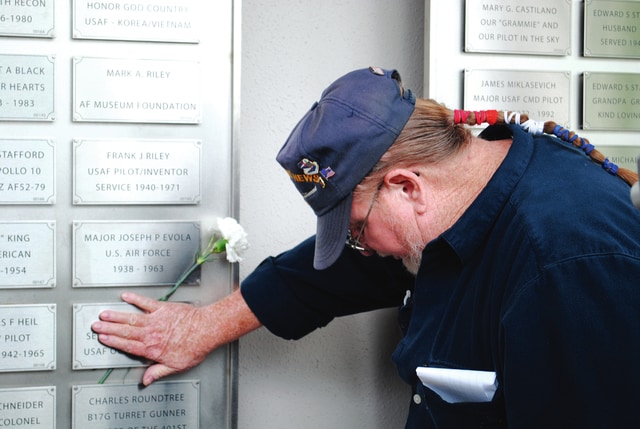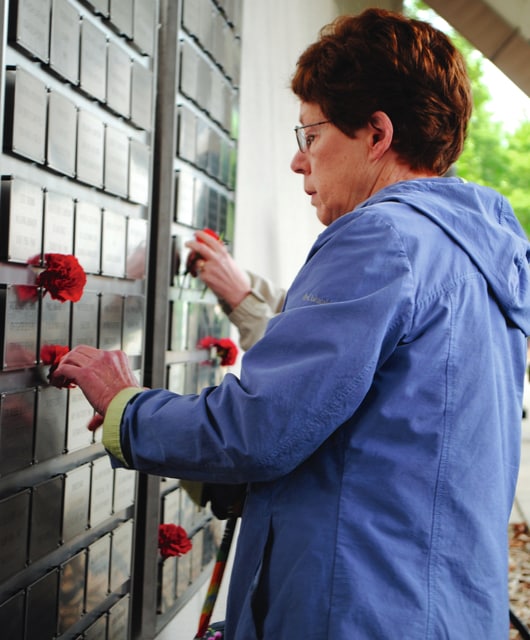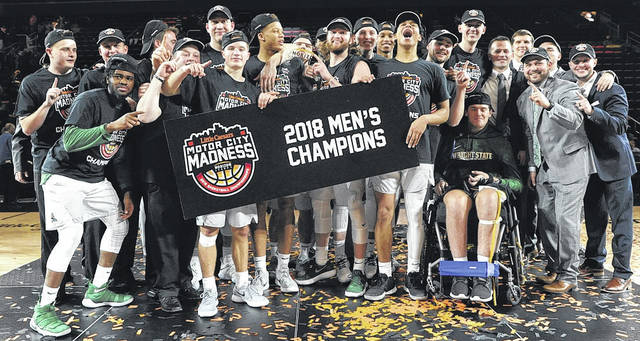



FAIRBORN — More than 850 individual stories are represented at the National Museum of the United States Air Force Legacy Data Plate Wall, which allows citizens who have been impacted by particular individuals to dedicate a stainless steal plate and tell their story on the accompanying website in their honor
“I wanted everybody who didn’t have a place in the museum already to have a place in the museum. We’ve got probably thousands of people we recognize, but there were millions of people who contributed to the efforts that have happened to this point,” Membership Director and Development Associate Matt Lynch of the National Museum of United State Air Force said, adding that he conceptualized the wall. “They all have a story. That was probably my biggest aspiration — we be able to tell all of those stories in another way.”
The museum’s third annual Legacy Data Plate Wall of Honor Tribute Ceremony was held Thursday, as it is each year before Memorial Day, allowing those impacted to gather and hear some stories of individuals who have plates.
The ceremony included keynote speaker Col Susan Richardson, who is retired from the United States Air Force and serves as the secretary of the Air Force Museum Board of Trustees. As this month marks the 70-year anniversary of the end of World War II, the ceremony included stories of three WWII pilots, including 1st Lt. William Case, Maj. Antonio Fasano and 2nd Lt. Robert Larbes.
Brian Moran of Turner Construction additionally shared stories of his father Staff Sgt. James Moran, and father-in-law Sgt. Ralph Windsor, who both have places on the wall.
After the ceremony ended, attendees were encouraged to place flowers along the plates of their loved ones.
“Every year we have this ceremony and after everything is said and done, the best part is watching people grab a flower and pay their tributes,” Lynch said. “You’re sticking that flower behind that plate, with the thought and emotion behind it, that is really powerful.”
Not all stories were told during Thursday morning’s ceremony. However, the impact of the wall itself remained firm. Janet Hockenberry dedicated a plate to her husband and feels that it’s a great way to honor those who have served.
“It’s beautiful,” she said. “I not only had a husband who served, but I also had two brothers in the Navy. I don’t have their plates on the wall, but that’s a goal for me.”
Each story can be viewed online at legacydataplates.com. Lynch hopes to eventually fill the wall with plates and stories, and feels that the wall provides an avenue for individuals to remember and honor their loved ones.
“We can put about 12,000 plates up, and we want to tell all those stories,” he said. “The hope is that it continues to expand, celebrate and honor the names on the wall. Hopefully we run into the problem that we’ve ran out of space and have to find another place.”
Lynch recalls a woman who stopped by the wall each week to leave red roses at her late husband’s plate. Eventually, museum officials began to take notice and would expect her visitations. One week, she left yellow roses instead of the usual red, causing individuals working within the museum to take notice. She explained that during her wedding, she carried three yellow roses and that particular week was their anniversary.
“I thought that it was just incredible that, not only are we putting up a tribute or honorary for people, but they’re utilizing it in a really powerful way,” he said.
The Legacy Data Plate Wall was born in April 2012 after Lynch was asked to design a brick dedication program for the museum. However, after conducting research and deciding that bricks didn’t match the overall aesthetic of the museum, he began exploring multiple avenues. The plates are aviation-grade stainless steel, and resemble the traditional military aircraft data plates, which include information such as the aircraft model designation, serial number and additional facts. Lynch utilized the concept as a means to connect individuals to the museum, and feels fulfilled in doing so.
“Where else can you provide a service like that to be able to do that for someone?” Lynch said. “It’s incredible to be able to do that for someone.”
Individuals wishing to purchase a plate can find more information at legacydataplates.com. Plates are not just limited to those who have passed away or have served, although 95 percent of the plates are affiliated with the military. He hopes individuals realize that museum officials are there to help, especially in terms of portraying the message itself.
“It’s not just a piece of medal and dollars going back into the museum — it’s telling the story, and we want to help do that,” Lynch said.


